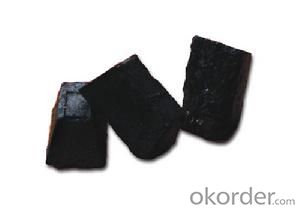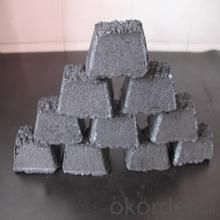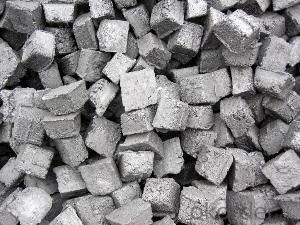High Quality Carbon Electrode Paste With Low Ash
- Loading Port:
- Lianyungang
- Payment Terms:
- TT OR LC
- Min Order Qty:
- 20 m.t.
- Supply Capability:
- 2000 m.t./month
OKorder Service Pledge
OKorder Financial Service
You Might Also Like
Spcifications
1:carbon eletrode paste
2:for ferroalloy,calcium carbide manufacture
3:HS 3801300000,YB/T5212-1996,ISO9001:2008
Product Description
Carbon Electrode Paste is a self-baking electrode used in submerged arc furnaces for delivering power to the charge mix. Electrode Paste is added to the top of the electrode column in either cylindrical or briquette form. As the paste moves down the electrode column the temperature increase causes the paste to melt and subsequently bake forming a block of electrically conductive carbon. Electrode Paste is essentially a mix of Electrically Calcined Anthracite (ECA) or Calcined Petroleum Coke (CPC) with Coal Tar Pitch.
Graphite/Carbon Electrode Paste
Specification/Item
Ash 4.0%max5.0%max 6.0%max7.0% Max9.0% Max11.0% Max
VM 12.0%-15.5%12.0%-15.5%12.0%-15.5%9.5.0%-13.5%11.5%-15.5%11.5%-15.5%
Strength
Compress 18.0Mpa Min17.0Mpa Min15.7Mpa Min19.6Mpa Min19.6Mpa Min19.6Mpa Min
Specific 65μΩm Max68μΩm Max75μΩm Max80μΩm Max90μΩm Max90μΩm Max
Resistance
Bulk Density1.38G/CM3 Min1.38G/CM3 Min1.38G/CM3 Min1.38G/CM3 Min1.38G/CM3 Min1.38G/CM3 Min
Picure:




- Q:How much is a ton of carbon fiber? How much difference is made between domestic and imported?
- Depending on what type, the difference is different
- Q:What are carbon credits and how do they work?
- Reducing greenhouse gas emissions through a market-based approach is what carbon credits are all about. The idea is to assign a value to the removal or reduction of one metric ton of carbon dioxide or its equivalent (CO2e) from the atmosphere. These credits represent the right to emit a specific amount of greenhouse gases and can be traded or sold on the carbon market. The main purpose of carbon credits is to create motivation for companies, organizations, or individuals to decrease their emissions. By establishing a price for carbon emissions, it encourages businesses to invest in cleaner technologies and practices to offset their carbon footprint. This ultimately leads to a decrease in overall greenhouse gas emissions, which contributes to the global fight against climate change. To acquire carbon credits, organizations undertake projects that reduce or eliminate greenhouse gas emissions. These projects can involve installing renewable energy sources, improving energy efficiency, planting trees, or investing in clean development mechanisms in developing nations. Independent third parties evaluate and verify each project to ensure its legitimacy and actual reduction in emissions. Once a project is approved and verified, it is given a specific number of carbon credits based on the amount of emissions it has reduced or eliminated. These credits can then be sold on the carbon market to companies or individuals seeking to offset their own emissions. Buyers can use these credits to compensate for their own emissions, effectively neutralizing their carbon footprint. The carbon market facilitates the buying and selling of carbon credits, providing a flexible and efficient approach to addressing climate change. The price of carbon credits can vary depending on supply and demand dynamics, as well as the strictness of emission reduction targets set by governments or global agreements. Overall, carbon credits are crucial in incentivizing emission reduction actions and promoting sustainable practices. They offer a financial mechanism for businesses to invest in cleaner technologies while making a positive contribution to global efforts in tackling climate change.
- Q:What is carbon neutral?
- Carbon neutral refers to achieving a state where the amount of carbon dioxide emitted into the atmosphere is balanced with the amount that is removed or offset. It is a widely used term in the context of addressing climate change and reducing greenhouse gas emissions. To become carbon neutral, one must first assess their carbon footprint, which involves calculating the greenhouse gases produced through activities like energy consumption, transportation, and waste management. Once the emissions are identified, steps are taken to decrease them through various methods, such as improving energy efficiency, utilizing renewable energy sources, and adopting sustainable practices. Although it is challenging to completely eliminate carbon emissions, it is crucial to reduce them. In cases where complete elimination is not possible, carbon offsets can be employed to compensate for the remaining emissions. Carbon offsets involve investing in projects that reduce or remove greenhouse gases from the atmosphere, like reforestation, renewable energy initiatives, or methane capture projects. By achieving carbon neutrality, individuals, organizations, or activities can assert that they are not contributing to the increase of greenhouse gases in the atmosphere. This is a significant objective in the battle against climate change, as it helps mitigate the adverse effects of carbon emissions and promotes a more sustainable and environmentally friendly future.
- Q:RT~ I remember our teacher said, but I forgot all of a sudden......Ask for advice!
- Such as esterification can be generated, as well as aldehydes oxidized into ketones, can produce carbonyl
- Q:What are the impacts of carbon emissions on the stability of permafrost?
- Carbon emissions have a significant impact on the stability of permafrost. Permafrost refers to the layer of soil, sediment, and rock that remains frozen for at least two consecutive years. It covers vast areas in the Arctic, subarctic regions, and high-altitude mountain ranges. One of the main impacts of carbon emissions on permafrost stability is the acceleration of climate change. Carbon dioxide (CO2) and other greenhouse gases trap heat in the atmosphere, leading to global warming. As temperatures rise, permafrost starts to thaw, causing a range of negative consequences. Thawing permafrost releases large amounts of stored carbon into the atmosphere. This carbon was previously locked in the frozen organic matter, such as dead plants and animals, which accumulated over thousands of years. As permafrost thaws, microbes decompose this organic matter and release greenhouse gases like carbon dioxide and methane. These emissions create a positive feedback loop, further exacerbating climate change and leading to more permafrost thawing. The release of carbon from thawing permafrost contributes to the overall increase in atmospheric greenhouse gas concentrations. This, in turn, amplifies global warming and global climate change. The impacts are not limited to the Arctic; they affect the entire planet. Rising temperatures, sea-level rise, extreme weather events, and disruptions to ecosystems are some of the consequences of global climate change. Permafrost thaw also affects infrastructure and human settlements in the Arctic and subarctic regions. Buildings, roads, pipelines, and other infrastructure built on permafrost can be destabilized as the ground beneath them softens. This can lead to structural damage and economic losses. Additionally, communities that rely on permafrost for traditional activities such as hunting, fishing, and transportation face challenges as the landscape changes. The impacts of carbon emissions on permafrost stability are not only local but also global. The release of stored carbon from permafrost contributes to climate change, which has far-reaching consequences for ecosystems, economies, and societies worldwide. It is crucial to reduce carbon emissions and mitigate climate change to preserve permafrost and its vital role in the Earth's climate system.
- Q:What are the environmental impacts of carbon emissions?
- The environmental impacts of carbon emissions include climate change, air pollution, ocean acidification, and ecosystem disruptions. Carbon emissions contribute to the greenhouse effect, leading to global warming and climate change. This results in more frequent and intense extreme weather events such as hurricanes, droughts, and heatwaves. Additionally, carbon emissions contribute to air pollution, especially in urban areas, leading to respiratory problems and other health issues. Increased carbon dioxide in the atmosphere also leads to ocean acidification, threatening marine life and coral reefs. Finally, carbon emissions disrupt ecosystems by altering the natural balance of carbon cycles and causing habitat loss for many species.
- Q:Where are carbon fiber sheets and carbon fiber sheets used?
- Fiber cloth can be made into fiberboard. You'd better say the actual product.
- Q:Why is the longer the carbon chain, the better the hydrophobic properties?
- The carbon chain is the water chain, but the lower the polarity (TA)They have to write fifteen characters ah from702853 (station link TA) can theoretically explain it zhoupeng87 (station link TA) should be the basic alkyl is not hydrophilic, it belongs to the hydrophobic group, the increase of carbon chain length of the hydrophobic whyy0113 (station TA) carbon chain is longer, the more polar groups easily entrapped nature shows hydrophobic alkane name small Jia (TA station) the carbon chain length of hydrophobic chain length, of course, hydrophobic. Cher (station TA) the alkyl chain is hydrophobic, so the longer hydrophobic part content more hydrophobic natural good red sandalwood fragrance (TA station).
- Q:How about carbon content of coal ash?
- Ash, carbon content, ash, carbon content, ash, carbon content, ash, carbon content, determination, determination, determination, determination (determination, determination)1 sampling(1) in the different positions of the ash, 7-10 points are deep to collect ash and 2-3kg. When sampling, not intentionally pick or avoid channels of ash, namely as ash samples taken, regardless of its size, regardless of the depth of color, regardless of its hardness, as far as possible to obtain a fully representative sample.(2) slag made on thick steel plate clean, which is smashed big gray block, mixing evenly into a cone, flattened, with a shovel cut ten sub center line, which is divided into 4 parts, two samples of diagonal, the other half abandoned.(3) repeat (2) operation. Reduce the amount to several times, until the ash is reduced to about 50 grams. Bring the ash back to the laboratory. The abandoned ash is discharged back into the ash heap.2, sample preparation(1) the ash in the laboratory will be retrieved and dried in a heated air drying oven (about 1 hours) at 105-110 degrees centigrade.(2) crushing the dry ashes with the disc vibrating mill, and the fine ash powder is the analysis sample.
- Q:Benefits of reducing carbon emissions
- 2, slow down the greenhouse effect. 1) the increase of diseases and insect pests on the earth;2) sea-level rise;3) the climate is abnormal and the ocean storm is increasing;4) the land was dry and the desertification area increased.Scientists predict that if the earth's surface temperature at the present rate of progress, by 2050 the global temperature will rise 2 to 4 degrees Celsius, the polar ice will melt significantly, resulting in a significant rise in sea level, some island countries and coastal city will be submerged in the water, which consisted of several famous international City: New York Shanghai, Tokyo and Sydney.The greenhouse effect can threaten prehistoric human beings with deadly virusesU.S. scientists recently warned that due to rising global temperatures to the Arctic ice melt, frozen hundreds of thousands of years of prehistoric deadly virus may lead to a global epidemic delivered from oppression, panic, human lives are threatened.Syracuse University of New York scientists in the latest issue of "scientists" magazine pointed out earlier, they found a plant virus TOMV, the virus spread widely in the atmosphere that has its traces in the Arctic ice.
1. Manufacturer Overview |
|
|---|---|
| Location | |
| Year Established | |
| Annual Output Value | |
| Main Markets | |
| Company Certifications | |
2. Manufacturer Certificates |
|
|---|---|
| a) Certification Name | |
| Range | |
| Reference | |
| Validity Period | |
3. Manufacturer Capability |
|
|---|---|
| a)Trade Capacity | |
| Nearest Port | |
| Export Percentage | |
| No.of Employees in Trade Department | |
| Language Spoken: | |
| b)Factory Information | |
| Factory Size: | |
| No. of Production Lines | |
| Contract Manufacturing | |
| Product Price Range | |
Send your message to us
High Quality Carbon Electrode Paste With Low Ash
- Loading Port:
- Lianyungang
- Payment Terms:
- TT OR LC
- Min Order Qty:
- 20 m.t.
- Supply Capability:
- 2000 m.t./month
OKorder Service Pledge
OKorder Financial Service
Similar products
New products
Hot products





























